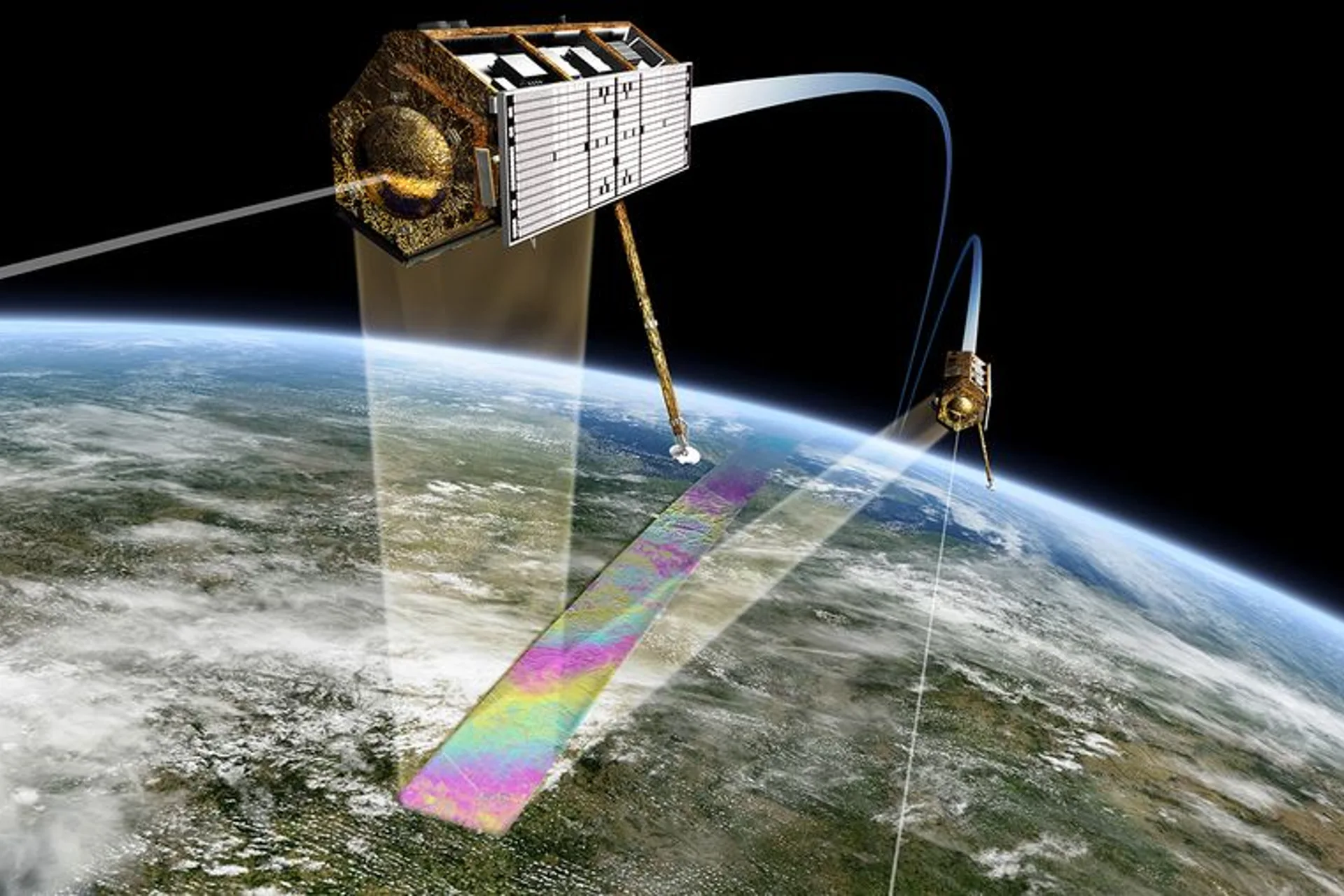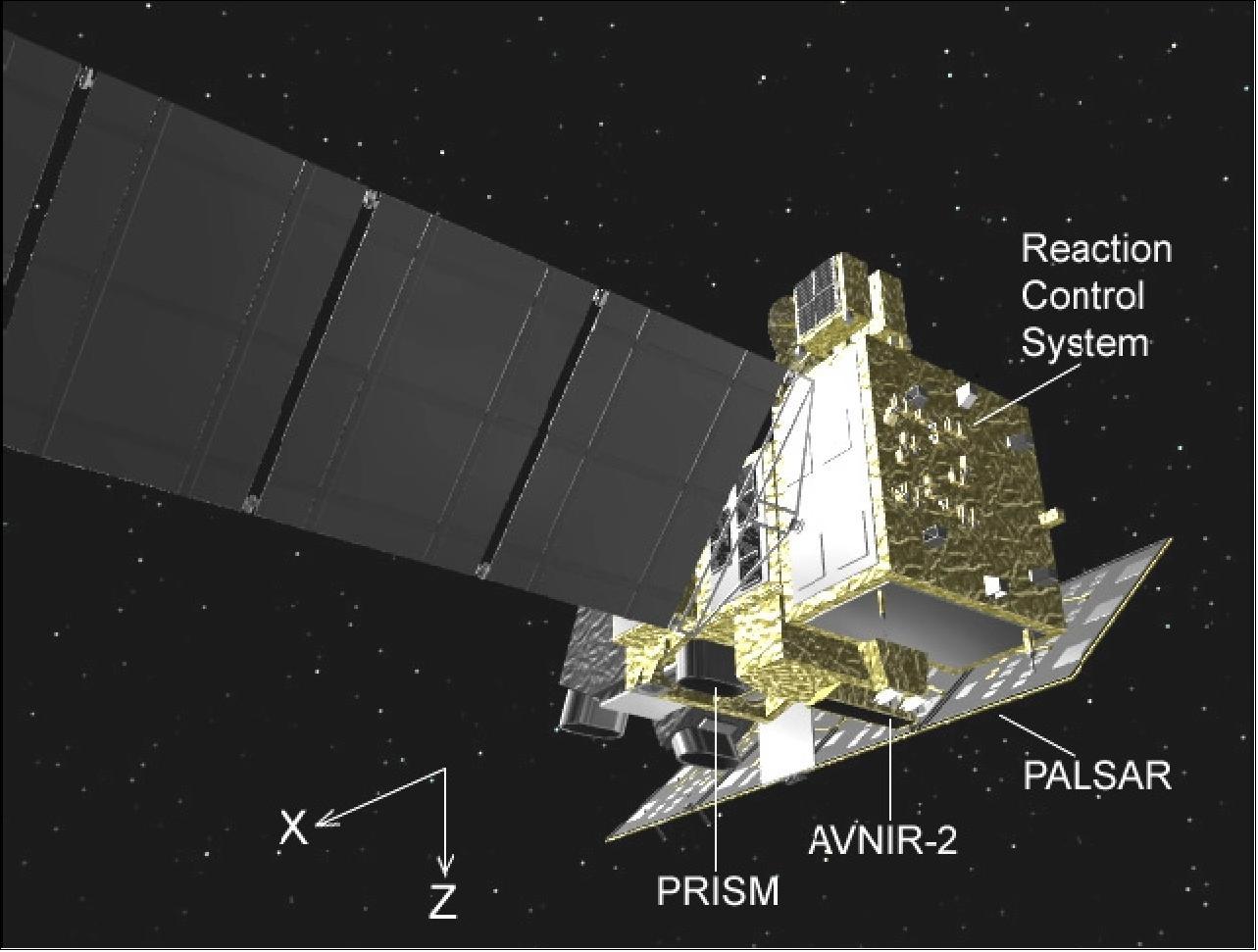ICEYE
ICEYE is a Finnish company that operates a growing constellation of small, commercial Synthetic Aperture Radar (SAR) satellites. The first satellite, ICEYE-X1, was launched in 2018 as a technology demonstrator. Since then, ICEYE has rapidly expanded its fleet, providing high-resolution SAR imagery with frequent revisit times, making near real-time monitoring possible.
ICEYE satellites primarily operate in the X-band, capturing images in all-weather, day-and-night conditions. Their applications include maritime monitoring, environmental monitoring, infrastructure management & disaster response (earthquakes, floods etc.).
ICEYE is notable for leveraging small satellite technology to reduce costs & increase agility compared to traditional SAR satellites, enabling rapid tasking & more flexible data access both commercial & government clients.
Sentinel-1
The Sentinel-1 mission is part of European Space Agency's Copernicus Earth observation program, designed to provide continuous, day-and-night, all-weather radar imagery of the Earth. Sentinel-1 is a constellation of twin satellites that monitor the land (mapping forests, agricultural areas & land use changes), Disaster management (floods, earthquakes etc.), Maritime Surveillance (monitoring sea ice, ships and oil spills), Geohazard & Terrain Motion (detection of landslides, subsidence, volcanoes etc.) and environmental monitoring (observation of soil moisture, glacier dynamics etc.). Sentinel-1's C-band SAR provides high resolution, all-weather images with a combination of Stripmap, Interferometric Wide (IW), Extra Wide (EW) and Wave Modes, allowing flexible imaging for diverse research and operational needs.
TerraSAR-X
TerraSAR-X is a German Earth observation satellite launched on June 15 2007, through a public-private partnership between German Aerospace Center & Airbus Defense & Space. The satellite operates in X-band radar frequencies (9.65 GHz) providing high resolution imagery for various applications. The main mission of TerraSAR-X is Earth observation (environmental monitoring, disaster management & land use mapping), Scientific Research (Data for scientific studies in geology, oceanography & hydrology) & Commercial Applications (in sectors like agriculture, forestry & urban planning). Said satellite operates in Spotlight mode, Stripmap mode and ScanSAR Mode. Further applications TerraSAR-X supports are disaster management, infrastructure monitoring, environmental monitoring & military & security.
COSMO-SkyMed
COSMO-SkyMed is an Earth observation mission developed by the Italian Space Agency (ASI) in collaboration with the Italian Ministry of Defense. The COSMO-SkyMed is a constellation that consists of multiple satellites equipped with X-band SAR systems. These satellites operate in several imaging modes and more specifically Spotlight Mode, Stripmap Mode and ScanSAR Mode. The constellation's main focus is Earth observation, Military & Security Applications, Risk Management & Scientific Research. The data it selects has many applications in Disaster Management (natural disaster damage assessment), Military & Security (providing intelligence for defense & border security operations), Environmental Monitoring (deforestation tracking, urban expansion etc.) & Infrastructure Monitoring (detection of ground movements and monitoring the stability of structures such as bridges).

Source: Spaceconomy360, “COSMO-SkyMed in orbita: Colao, straordinaria competenza italiana nell’osservazione della Terra,” (https://www.spaceconomy360.it/politiche-spazio/cosmo-sky-med-in-orbita-colao-straordinaria-competenza-italiana-nellosservazione-della-terra/ )
RADARSAT
RADARSAT is a series of Canadian Earth observation satellites developed by the Canadian Space Agency (CSA). With the use of C-band Synthetic Aperture Radar imagery is provided in all-weather conditions & day-and-night. RADARSAT's mission is to monitor sea ice & maritime traffic, providing data for environmental & climate research, urban development & land-use mapping, agriculture & forest monitoring, flood & disaster management. These satellites have played a critical role in the demonstration of the value of SAR for commercial, scientific & operational applications, offering reliable observation of our planet regardless of lightning and weather conditions.
KOMPSAT
KOMPSAT also known as the Korean Multi-Purpose Satellite, is a series of Earth observation satellites developed by the Korean Aerospace Research Institute (KARI). Several KOMPSAT satellites carry Synthetic Aperture Radar (SAR) instruments, designed to provide high-resolution, all-weather, day-and-night imagery for scientific, civil & defense applications. The timeline for the KOMPSAT series is:
KOMPSAT-1: launched in 1999, focused on Earth observation & mapping.
KOMPSAT-2: launched in 2006, with improved spatial resolution for civilian & scientific applications.
KOMPSAT-3: Launched in 2012, featuring very high-resolution imagery for detailed observation.
KOMPSAT-5: Launched in 2013, the first satellite in the series equipped with C-band SAR for all-weather operation.
KOMPSAT-3A: Launched in 2015, equipped with an infrared sensor for thermal imaging.
KOMPSAT-6: Planned/launched recently (depending on mission status), equipped with advanced SAR for continuous monitoring.
There are future planned missions that will expand coverage, increase revisit frequency & support a wider range of applications.
KOMPSAT satellites are very useful for environmental monitoring & land-use mapping, ocean & maritime surveillance, infrastructure monitoring & urban planning, disaster & emergency response and lastly defense & security operations.

Source: e-GEOS, “KOMPSAT Constellation”, e-GEOS satellite data page (https://www.e-geos.it/en/satellite-data/kompsat-constellation/)
TanDEM-X
TanDEM-X is a German Earth observation satellite launched in 2010 by the German Aerospace Center (DLR) in partnership with Airbus Defense & Space. It operates together with its twin TerraSAR-X, flying in close formation with the goal to perform single-pass interferometric SAR measurements. The mission's primary goal was to create a high-resolution, global digital elevation model (DEM) of our planet with unprecedented accuracy.
The global DEM was completed in 2016 and it's widely used in applications such as infrastructure planning, hydrology, environmental monitoring and defense. TanDEM-X continues to deliver valuable interferometric SAR data for scientific & commercial purposes, showcasing the potential for twin-satellite SAR constellations for precise 3D mapping.

Source: IndustryRadar, “Satellite service monitors ground for construction” — image source: NGI (https://industryradar.com/norway/new-satellite-service-monitors-ground-movements-for-construction-projects/)
ALOS-1
The Advanced Land Observing Satellite (ALOS-1), also known as Daichi, was launched by the Japan Aerospace Exploration Agency (JAXA) in 2006. It is equipped with multiple sensors, including the Phase Array Type L-band Synthetic Aperture Radar (PALSAR), which provided Earth observation without weather or lighting restrictions. ALOS-1's mission objectives included cartography, land use observation, forestry, agriculture, resource exploration & cartography.
The L-band SAR capability of ALOS-1 allowed for penetration through vegetation canopies & gather critical information about soil moisture, forests, & land deformation making it especially handy for environmental monitoring.

Source: eoPortal / ALOS — “Quick Facts” section, eoPortal satellite missions page (https://www.eoportal.org/satellite-missions/alos#eop-quick-facts-section)
Capella
Capella Space is a U.S. based company that operates a growing constellation of commercial SAR satellites. The first satellite, Capella-1 (Denali), was launched in 2018 as a technology demonstrator. Since then, Capella has deployed several operational satellites that deliver high-resolution X-band SAR imagery with rapid revisit times.
Capella's mission is to provide near real-time, no weather and lighting restrictions, Earth observation for applications such as disaster response, defense & intelligence, infrastructure monitoring, environmental change detection & marine time surveillance.
Unlike several prior government-driven SAR missions, Capella focuses on on-demand, commercially available data, deeming SAR imagery more accessible to industries and organizations worldwide.
Umbra
Umbra is a company based in the United States that operates a constellation of commercial Synthetic Aperture Radar (SAR) satellites. The first operational satellite was launched in 2021, since then the fleet has expanded to provide very high resolution X-band SAR imagery, with resolutions down to 25cm, among the sharpest available commercially.
Umbra's mission is the delivery of affordable, on-demand SAR data for a variety of applications, including, environmental monitoring, infrastructure tracking, maritime domain awareness, defense & disaster response, with its main focus to democratize access to SAR technology beyond government & military users.